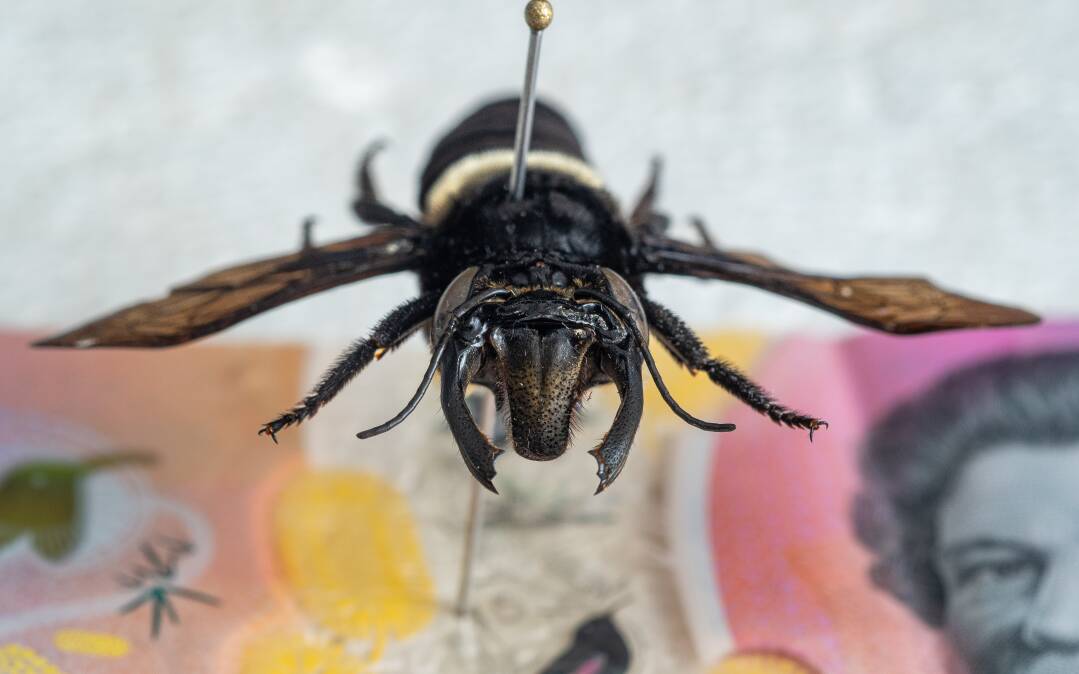With the strong smell of the mothball-chemical naphthalene lingering, a wander through the hallways of the Australian National Insect Collection reveals not only the world's largest bee - ahead of World Bee Day on Saturday - but a tale of an international racket in rare insects.
The insect collection at the CSIRO at the base of Black Mountain in Canberra is in possession of two examples of the world's largest bee, Wallace's Giant Bee (Megachile pluto), which were seized by biosecurity officers after the dead bees were sold online.
The specimens were intercepted in 2021 and transferred to the CSIRO last year for safekeeping among its 12 million research specimens.

Visiting CSIRO scientist Dr Michael Elias said Wallace's Giant Bee, native to a cluster of islands in Indonesia, were extremely rare and the two in Canberra, a male and a female, were the only ones held by an institution in Australia.
"As far as we know - unless someone has been smuggling them into the country without us knowing about it," he said.
While the details are tightly-held, someone was smuggling them into Australia, at least in 2021 when individuals were trying to sell dead specimens of Wallace's Giant Bee on eBay, two of which were intercepted by biosecurity officers from the Department of Agriculture.
"They were smuggled into Australia, someone was selling them illegally online and it was purchased by an address in Australia," Dr Elias said.
"It's illegal to sell them because they're a listed species, listed as vulnerable.
"I can't tell you how much this one went for but they were being sold for several thousand dollars each. It's into five figures."

The world's biggest bee is definitely hard to miss.
The female Wallace's Giant Bee dwarfs a standard European honey bee, with a wingspan of 63.5mm, compared to the honey bee's wing span of 18-20mm.
Dr Elias said the bees were discovered in 1858 by British naturalist Alfred Russel Wallace, a contemporary of Charles Darwin and fellow exponent of the theory of evolution by natural selection.
The bees were thought extinct when no further specimens were found until they were rediscovered in Indonesia in 1981. They re-emerged again in about 2017, in less hopeful form, when online sales of dead specimens started.

The inclusion of Wallace's Giant Bee in the collection was important for research.
"So as a reference collection, the more different species you have, the more valuable the collection," Dr Elias said.
Dr Elias said Wallace's Giant Bee was not in the same vein as the hard-working European honey bee, instead making a resin-like substance, secreted in termite nests, protected by the resin.
"It is a pollinator, but not on a commercial level," he said.
"It's value to us is as one of the few examples of this species that actually exist. It's a very rare example of reference material which very few museums have, so we're very lucky to have it."
It was not even clear what plants the Wallace's Giant Bee pollinated.
"It is possible it's a very specific thing and that's why they're so rare," he said.

For Dr Elias, who works for the Department of Agriculture in biosecurity, the smuggling in of the Wallace's Giant Bees was a bit of intrigue as opposed to other insects that come into Australia by accident on cargo, including fresh produce.
"Occasionally, with these charismatic species, like Wallace's Giant Bees, we get people smuggling them. Tarantulas, we get people smuggling them. Sometimes live even," he said.
- World Bee Day on Saturday encourage actions that create more bee-friendly landscapes.







